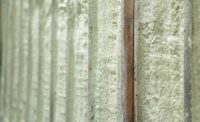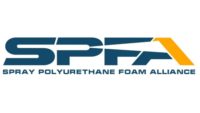AEC/O+M Solutions
Spray Polyurethane Foam: A Candid Look

In today’s construction industry, many incredible advances in engineering have made high-performance buildings not only possible but increasingly common. From LED lighting to more efficient HVAC systems, today’s buildings feature greater energy savings than ever before.
One product that plays a major role in the overall efficiency of a home or building is the insulation. Among its many benefits, spray polyurethane foam (SPF) helps control heat loss or gain, reduce air infiltration and decrease HVAC requirements. It can be a water-resistant material reducing the flow of moisture through a structure. It helps dampen sounds from other rooms, add structural strength and can even be used as a seamless low-slope roofing product on some buildings.
As more green building professionals turn to SPF to meet their project’s high-performance goals, they will need to understand when to use SPF and which type is right for that application.
Which Type Do I Choose?
SPF can be used in many different places and types of buildings. With three different types of SPF, how do you know which one to use? SPF is categorized as either open-cell or closed-cell, which simply refers to the cellular structure of the foam and its density.
If you are looking to simply insulate and air seal the underside of a roof deck, over a ceiling, inside a perimeter wall or under a floor, low-density, open-cell SPF—also called half-pound SPF—is frequently considered. This type is a soft, flexible polyurethane foam that is moisture permeable. Its foam-in-place nature lends itself well to sealing cracks and cavities found in the building envelope. Typically, half-pound SPF has an R-value of R-3.5 to R-4 (per inch of thickness).
Medium-density, closed-cell SPF, also known as two-pound foam, is the most versatile type of SPF insulation. In addition to the applications typical of half-pound SPF, two-pound foam can be used to insulate the outside of perimeter walls, slabs and foundations, as well as more demanding industrial applications. It’s a more rigid foam that provides greater insulation properties and strength. The R-value of two-pound SPF typically falls between R-6 and R-7 (per inch of thickness). At a thickness of about two inches, medium-density SPF provides a vapor retarder needed to control moisture condensation in colder climates.
The third type of SPF is useful as a roofing system for flat-roofed, typically commercial or institutional buildings because it is rigid, has high compressive strength, insulates well and forms a seamless surface. This type is known as three-pound foam. Like medium-density SPF, it has a closed-cell structure. The higher density of roofing foam provides additional compressive strength needed for roofing applications.
SPF: A Highly Effective Building Material
SPF is made of two primary components—an isocyanate and a polyol blend—that when mixed on the jobsite react to form the polyurethane foam, which expands within seconds to fill in the spaces being sprayed. Once formed, the foam hardens very rapidly. How long it takes for the reaction to fully complete depends on the type of SPF insulation and other variables. A professional contractor can give you guidance about when you can go back into the building after application. In addition to SPF, isocyanates are used in the production of things like refrigerator insulation, sports equipment and paints.
Like many construction products and building materials, SPF needs to be handled according to the manufacturer’s recommendations and installed by a qualified professional. When properly mixed and applied, SPF is an effective insulation. In fact, according to the U.S. Environmental Protection Agency, after spray foam is applied and cured, it is considered to be relatively inert, which means the chemicals are no longer reacting.
 Current building codes and manufacturer’s recommendations indicate how SPF is properly installed. For example, fire protection measures for all foam plastics are detailed in Section 2603 of the current International Building Code for commercial buildings, and in Section R316 of the International Residential Code for one- and two-family dwellings. To ensure that a particular SPF product meets the building code, it is tested and installed according to the code requirements. One way to determine if the SPF installation meets the building code is to work with an experienced SPF company; those at the company can explain and follow the product’s evaluation report available for most products.
Current building codes and manufacturer’s recommendations indicate how SPF is properly installed. For example, fire protection measures for all foam plastics are detailed in Section 2603 of the current International Building Code for commercial buildings, and in Section R316 of the International Residential Code for one- and two-family dwellings. To ensure that a particular SPF product meets the building code, it is tested and installed according to the code requirements. One way to determine if the SPF installation meets the building code is to work with an experienced SPF company; those at the company can explain and follow the product’s evaluation report available for most products.
While specific safety practices vary by SPF product and the conditions of each specific job, there are some safety measures that generally apply when installing SPF installation. These include building occupants and other contractors remaining outside the workspace during and immediately after SPF application. Professional installers seal off the workspace and use personal protective equipment (PPE) and ventilation during the installation process. Using PPE required by the U.S. Occupational Health and Safety Administration and following best practices can help the SPF applicators avoid exposure with chemicals during the SPF application process. The manufacturer provides recommendations for when to enter the work zone without PPE after the job is complete.
Similarly, just like many other combustible building materials, SPF is capable of burning and will emit smoke if ignited. According to building codes, in most instances SPF must be separated from the interior spaces of buildings using 15-minute thermal barriers or ignition barriers.</p> <p> Another reason to use a professional installer is they can explain how to maintain a minimum amount of ventilation in the building after the product is installed. Because SPF fills the cracks and gaps of a building, it is considered an air-impermeable air barrier. This means careful consideration needs to be taken to provide a minimum amount of ventilation to give the building proper ability to “breathe.” Without minimum ventilation, indoor air quality can be affected.
Benefits of SPF
According to the U.S. EPA, 25 to 40 percent of the energy used for heating and cooling in a typical home is directly attributable to unwanted air leakage. Studies have shown that using SPF can reduce this air leakage by three to five times, almost eliminating energy losses from air leakage in a typical home.
While SPF is most often associated with energy-saving properties, there are a number of other benefits:
- When used with a properly designed HVAC system, SPF can prevent infiltration of outdoor air that may contain pollutants and allergens.
- SPF helps minimize noise that travels through the air by preventing sound waves from passing through gaps or cracks in a building.
- SPF helps control moisture movement and mitigates the potential for condensation and mold and mildew growth. Closed-cell SPF, applied to about a two-inch minimum thickness, meets the Class II vapor retarder requirements of the model building codes.
- SPF can even add structural reinforcement to certain buildings, making it an excellent choice for buildings subject to a higher risk of flooding or excessive winds.
With so much to know about SPF, it is clearly important for green building professionals to learn more about this product so that they can achieve the building performance they desire. For more information, visit www.whysprayfoam.org.
Looking for a reprint of this article?
From high-res PDFs to custom plaques, order your copy today!






